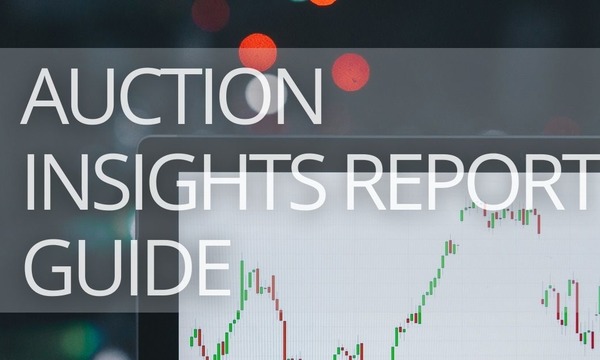If you’re into PPC marketing, you might have heard about Wordstream. Larry Kim’s startup has grown into a widely-known platform for marketers and small business owners. However, when it comes to specific automation features, does Wordstream match all the advertisers’ needs? Is Wordstream worth using? What do you really pay for when you opt-in for this platform?
From this overview, you’ll learn how Wordstream works and discover its main features in comparison to PromoNavi, a PPC automation platform that competes with Wordstream and provides PPC marketers with a toolkit enabling them to automate the most time-consuming tasks.
At the end of the article, you can find a comprehensive comparison table of these two platforms.
Let’s get started!
Quick Links
PromoNavi vs. Wordstream Overview
PromoNavi vs. Wordstream: Similar Features
PromoNavi vs. Wordstream: Unique Features
PromoNavi’s unique features and tools
Automated Google Ads Campaign Builder
Google Ads Automation App for Shopify
Wordstream’s unique features and tools
PromoNavi vs. Wordstream: Affiliate Programs Comparison
Pros & Cons of PromoNavi & Wordstream
PromoNavi vs. Wordstream: The Comprehensive Comparison Table
PromoNavi vs. Wordstream Overview
What is PromoNavi?
PromoNavi is a PPC automation platform for digital marketers. It provides a comprehensive PPC toolkit for in-house marketers and small business owners who run ads by themselves.
PromoNavi started in 2013 as a toolkit for the internal needs of the Russian digital agency. A breakthrough year for the platform was 2015 as it joined the Google Premier Partner Program. In 2017, PromoNavi became a standalone platform—everyone could sign up and try it out. One year later, PromoNavi was launched in Poland.
In 2019, PromoNavi was launched worldwide—promonavigator.com became available throughout the globe. Today, PromoNavi is a platform that serves more than 8000 clients from 54 countries, including the US, UK, Australia, Spain, Hungary, Netherlands, Germany, Canada, India, and others.
Here are the PromoNavi features and tools:
- Analytics Dashboard
- Competitor Analysis
- Keyword Planner
- Automated Google Ads Campaign Builder
- Keyword Wrapper
- Keyword Lists
- Campaigns Optimization
- Account Alerts
- PPC Reporting
- Google Ads Automation App for Shopify
(We’ll highlight each tool below.)
Supported advertising platforms:
- Google Ads
- Microsoft Advertising
- Facebook Ads
- + Shopify integration
What is Wordstream?
Founded in 2007, Wordstream in its concept is similar to PromoNavi: it provides marketers with PPC automation tools to save time creating and managing their campaigns. At its core, there is a 20-Minute Work Week, a tool that analyzes connected accounts and suggests improvements, such as bid adjustments, new keywords, negative keywords, etc.
The list of Wordstream’s features and tools:
- Dashboard
- Keyword Planner
- Wordstream Advisor
- PPC Reporting
- Call tracking
- Conversion toolkit
Supported advertising platforms are:
- Google Ads
- Microsoft Advertising
- Facebook Ads
PromoNavi vs. Wordstream: Similar Features
PromoNavi and Wordstream, as they are PPC automation platforms, have some similar features. However, similar doesn’t mean the same. Let’s find out what similar tools each platform has and what the differences are.
Analytics dashboards
Both Wordstream and PromoNavi have dashboards that display key performance trends across accounts.
Wordstream’s dashboard displays only 5 metrics, including Conversions, CPA, Clicks, CPC, and Ad Spend. You can see nothing but trend charts for each metric here—meaning that analytical opportunities of the Wordstream’s dashboard are limited.
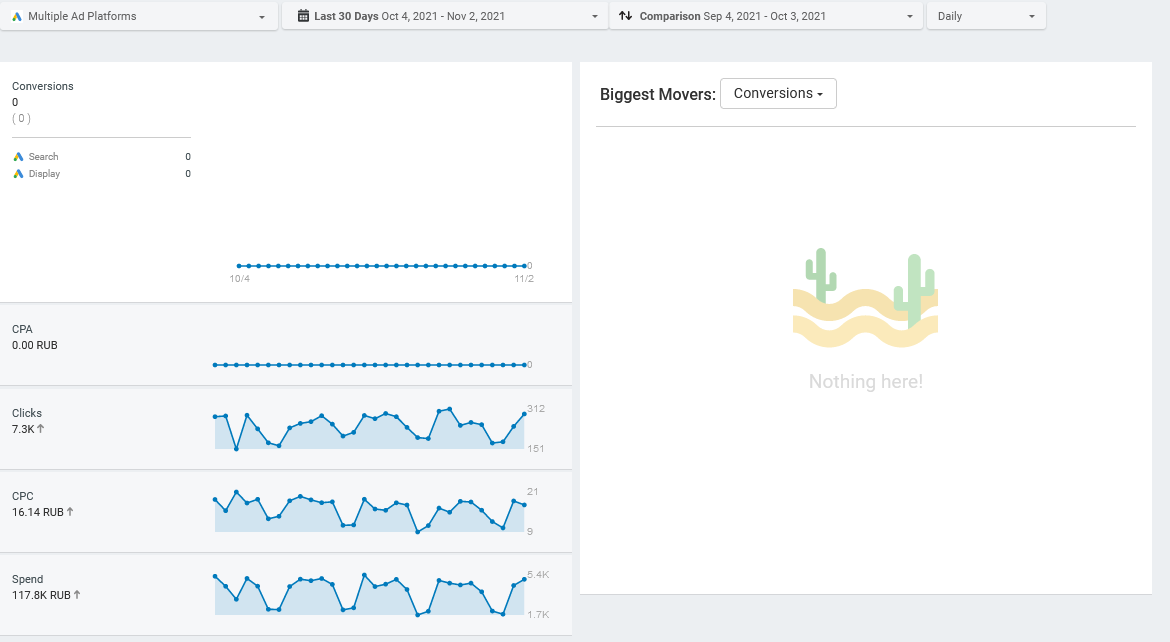 Here is how Wordstream’s dashboard looks
Here is how Wordstream’s dashboard looks
In contrast to Wordstream, PromoNavi’s Dashboard is a much more functional tool enabling users to track cross-account and cross-campaign performance in real-time, discover better and less performing audience segments, and uncover abnormal trends.
The key features of PromoNavi’s Dashboard are:
- Tracking 11 metrics and KPIs, including ROAS.
- Interactive charts that allow you to compare up to 4 metrics at once.
- Widgets with significant changes within accounts and campaigns during the given time range.
- Optimization recommendations widgets.
- Account performance across segments (Network, Device, Gender, and Age)
- Data segmentation across specific conversion goals.
- The most significant metrics visualization on the charts.
Summary
Wordstream’s dashboard is quite basic: you can see only how 5 metrics change through time. You can’t segment data to find well-performing audiences; you can’t compare metrics changes on the charts; you can’t analyze stats across goals, etc.
Unlike Wordstream, PromoNavi provides a full-fledged tool to keep an eye on your campaigns in real-time. You can compare the data across accounts, campaigns, and audience segments to discover what is really going on in your accounts and refine your PPC strategy in a timely manner.
PromoNavi vs. Adzooma: Which PPC Automation Platform Is Better?
Keyword Planner
Wordstream’s Keyword Planner is rather simple: you enter a basic keyword or URL, choose the industry, country, and press the Search button. In the table, you can see all the keywords that match your conditions. For each keyword, the system displays Search Volume, Competition, Average CPC, and Opportunity Score. The latter metric is based on Wordstream’s algorithms and is used to score the advertising opportunity (1—poor, 10—best).
To access the Keyword Planner, you need to navigate to the Manage section; from the drop-down, choose Google or Microsoft, and open the Keyword research tab.
PromoNavi’s Keyword Planner works in a similar way but has a number of significant differences making it more suitable for everyday keyword research.
- You can enter more than 1 basic keyword per search so that you’re able to complete your keyword research within a single iteration.
 To get started with PromoNavi Keyword Planner, enter basic keywords
To get started with PromoNavi Keyword Planner, enter basic keywords
- The tool finds 3 types of keywords: Phrase-match keywords, Related keywords, and Auto completions. They are split into 3 self-titled tabs, so you have an opportunity to significantly expand your keyword list.
- For each keyword, you can see an Average monthly search chart so that you can estimate seasonality and find whether the specific keyword is trendy or already not a popular one.
- Quick filters enable you to hide irrelevant keywords and save time choosing the right keywords for your campaigns.
- You can add keywords to existing keyword lists or create a new list. These lists are stored in PromoNavi and you can use them in the following keyword research.
- You can build a new Google or Microsoft Ads campaign or add keywords to existing campaigns.
Summary
Wordstream’s Keyword Planner gives advertisers fewer opportunities than the one for PromoNavi. For instance, for the keyword “ppc” in the US, PromoNavi collected 1893 keywords while Worstream found only 617. Moreover, in Wordstream, you can’t filter keywords, create keyword lists, discover seasonal trends, and group keywords.
That is why, if you want to provide faster and more in-depth keyword research, PromoNavi’s Keyword Planner will work better for you.
7 Ways to Find the Best PPC Keywords [Guide to PPC Keyword Research]
Optimization recommendations
Wordstream’s optimization tool is called 20-Minute Work Week. The system analyzes connected accounts and suggests opportunities, such as high-performing and low-performing keywords, bid adjustments, placement optimizations, ad groups splitting, pausing duplicates, etc.
You can click on recommendations details and apply it to your accounts directly from Wordstream.
PromoNavi has optimization tools as well. However, the difference is that PromoNavi aggregates stats from Google Ads and Google Analytics, including behaviour metrics; based on these stats, the AI-driven algorithm suggests improvements (new effective keywords, negative keywords, ineffective keywords, bid adjustments, find broken links in your ads, etc.)
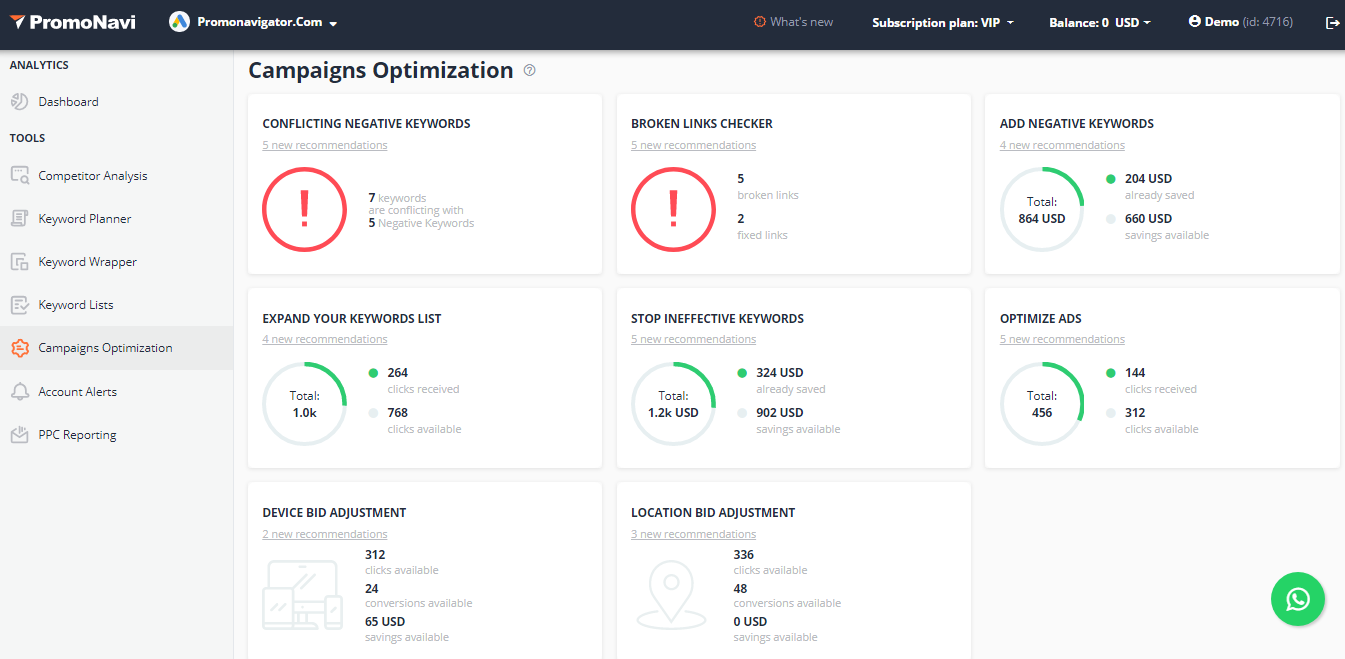 PromoNavi’s Optimization Recommendations
PromoNavi’s Optimization Recommendations
You can apply suggested improvements or decline them.
For instance, here is how PromoNavi displays new effective keywords:
For each suggested keyword, you can see comprehensive stats to decide whether you need to add them to your campaign. To add keywords, just tick them and press the “Add to Google Ads” button. Other recommendations work in a similar way.
Summary
Both platforms suggest improvements to help advertisers expand their audience reach and save money. However, PromoNavi presents its recommendations in a more organized way—you can see a table with recommended keywords or bid adjustments so you can quickly filter out the data and find what you need. Moreover, PromoNavi upload stats from Google Analytics—meaning that you can make decisions based on both performance and behaviour metrics.
Reports
Wordstream has two types of reports:
- Success reports. These reports contain the basic data to showcase the performance of your account. For instance, the Google Search report includes 6 pages: Performance Review, Account Health & Trends, Trends over Time, Activity During This Period, Top Performing Keywords, and Ads. You can schedule these reports or create them on demand. The report is available online, or you can download it as a PDF, send to email, or share a link.
- Account Performance Grader. The system estimates different aspects of your account performance and grades your account at the scale from 0% to 100%. By analyzing different components, such as Quality Score, CTR, or Ad Spend, you can find gaps in your PPC performance.
PromoNavi has two types of reports as well. They include more in-depth analytics, so they are useful not only for business owners but for PPC specialists.
In PromoNavi, you can set up the following reports:
- 16-page report for Google Data Studio. This is the most comprehensive GDS reporting template on the market. Within a single report, you can see all the essential performance data, from KPIs overview to Funnel report. You can segment the data by demographics, location, devices, and choose the date range. If you need to share the report, you can do it using the sharing link.
 The fragment of PromoNavi’s GDS report
The fragment of PromoNavi’s GDS report
- Scheduled PDF reports. With this tool, you don’t need to create reports for your clients or managers—you just enter recipients’ emails, and they’ll receive their PDF report copies weekly or monthly, depending on the schedule. These reports are available for Google and Microsoft accounts. These reports are white-labeling—meaning that you can place your logo on the report copies and present them as tailored by your agency. PDF reports support 5 languages: English, Russian, Italian, Spanish, and Hungarian.
 The fragment of PromoNavi’s Scheduled PDF report
The fragment of PromoNavi’s Scheduled PDF report
Summary
PromoNavi’s reports cover all the aspects of your PPC marketing, from general KPI to sales funnel and competitor analysis. You can choose between two different types of reports depending on your goals. You can schedule reports, and your clients will receive their copies weekly or monthly.
In Wordstream, there are up to 6 pages in the scheduled report, compared to 16 pages in PromoNavi’s GDS report. The Account Grader report is more in-depth, but it is more about optimization and opportunities than reporting.
PromoNavi vs. Wordstream: Unique Features
PromoNavi’s unique features and tools
Competitor Analysis
Before you run a PPC campaign, you need to take a look at your rival’s PPC strategies. With PromoNavi’s Competitor Analysis tool, you can do it in one click and get “secret” insights about your competitors:
- How many ads and keywords do they target?
- How much Paid traffic do they drive?
- What ads do they show?
- What keywords do they use?
- What keywords are you missing?
 The sample of the competitor analysis in PromoNavi
The sample of the competitor analysis in PromoNavi
The helpful feature in PromoNavi is that you can subscribe to your competitors’ updates. As soon as they run new ads or target new keywords, you’ll receive a notification, so that you’ll be able to timely adjust your PPC strategy if needed.
Want to learn more about competitor analysis? Here are 3 posts to help you with this:
- 10 Advanced Tips to Analyze Your PPC Competitors
- How to Find Paid Keywords Used by Your Competitors
- How Competitors Steal Your Branded Search Traffic [8 Strategies + 5 Countermeasures]
Automated Google Ads Campaign Builder
This tool completely automates your Google Ads campaign creation. The AI-driven algorithm collects keywords, groups them, finds negative keywords, crafts ad texts, defines targeting settings, and decides on a budget.
To get started, just select a campaign type (for now, Search and Display campaigns are available), enter your website URL, and the AI algorithms start handling routine tasks for you, including:
- Keyword research based on your website content. You can use keywords from the list or enter your own.
- Keyword grouping based on the search intent and cross-group negative keywords suggestions.
- Ads text creation. For each ad group, the tool creates headlines, descriptions, substitutes relevant URLs, and suggests callouts.
- Detailed targeting. You can target audiences by Device, Location, and Time.
- Traffic estimation. You can see how much traffic you can expect for a particular budget.
After the campaign is created, the tool exports it to your Google Ads account so you don’t need to deal with Excel tables.
Here is a quick tutorial video:
Keyword Lists
This tool enables you to manage keyword lists within the PromoNavi platform with no need to export/import keywords every time you do a keyword research.
With a Keyword Lists tool, you can top-up keyword lists with your own keywords, with keywords collected using PromoNavi tools, get insights on them, and build a Google Ads campaign directly from PromoNavi.
Keyword Wrapper
This tool converts keywords into 4 separate lists with different match type combinations. Also, you can clean up your keyword list: remove duplicates, remove special symbols, and convert keywords to a lowercase.
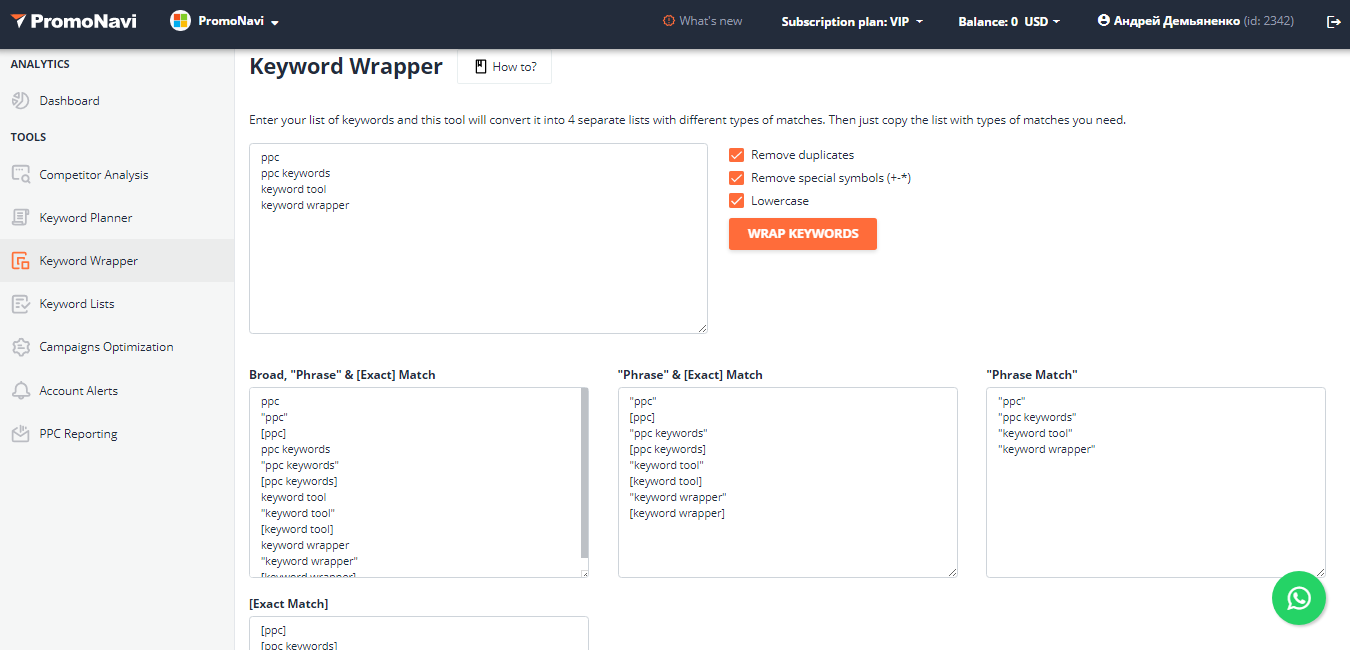 Here is how PromoNavi’s Keyword Wrapper works
Here is how PromoNavi’s Keyword Wrapper works
Account Alerts
PromoNavi Alerts helps you keep track of significant drops and rises in your PPC performance, outline your acceptable metric values, and instantaneously receive notifications if the system detects activities that seem out of the ordinary.
PromoNavi Alerts includes three alerting types:
- Anomaly Detector
- Budget vs Spend Tracker
- Balance Checker
With this tool, you do not need to dive into the automated rules or run scripts—you just need one minute of your time to set up alerts. Afterward, you will timely receive notifications to your email address or Telegram account.
Prefer using Google Ads scripts? Here are three compilations for you:
Google Ads Automation App for Shopify
If you run ads for a Shopify store, with this App, you can automate all the advertising stages, from keyword research and ad creation to optimization.
The key features of the App:
- AI-driven keyword research
- Intent-based keyword grouping
- Cross-group negative keywords
- Ad text generator
- Traffic estimator
- Automated merchant feed creation
You can learn more about the app or install it from the Shopify App Store right now.
Wordstream’s unique features and tools
PPC Management
You can manage your ad accounts within Wordstream—create a new campaign, add keywords and negative keywords, manage extensions, bid strategies, etc.
The good thing about the PPC management feature is that you can quickly switch between accounts in different ad platforms and have control over what’s going on out there. However, automation opportunities here are limited. For instance, when you create a new Google Ads campaign, you need to provide keyword research, find negative keywords, and tailor ad copies. To compare, PromoNavi’s Automated Campaign Builder does these tasks for you.
The other issue about Wordstream’s PPC management tool is that it doesn’t include all the options and settings available within Google Ads or Microsoft Advertising. Hence, you can’t adjust all the settings within Wordstream and you need to log in to your ad accounts to complete the campaign creation or adjust settings. That is why the PPC management tool is more suitable for beginners rather than pro users.
Conversion toolkit
Wordstream has a tool enabling advertisers to create pop-ups and landing pages by themselves with no need to dive into coding. You can choose from available pop-up and landing page templates and customize them according to your offer.
The Conversion toolkit is available within the basic Wordstream subscription, but its features are limited. To get full access, you need to make extra payments ($20/month and $65/month).
How to Set Up Conversion Tracking in Microsoft (Bing) Advertising
Call-tracking
This option is available at an additional cost only for the US and Canada users. To get started, you need to enter your business phone number and set up a call tracking code to your website. The system will track the calls and display the stats enabling you to analyze what ad channels perform better.
PromoNavi vs. Wordstream: Affiliate Programs Comparison
Wordstream doesn’t have an affiliate program. Hence, you don’t have an opportunity to make money acquiring new customers to the platform.
Unlike Wordstream, PromoNavi has a unique two-tier affiliate program with lifelong promo codes. An affiliate gets 50% recurrent commissions for every subscription sale + 30% of sub-affiliate sales.
For example, if your referral has paid for an Agency plan that costs $79/month, you will receive $39.50/month as a reward. If your affiliate attracts sub-affiliate for the same plan, you will receive an additional $23.70/month.
Here is an example of how much you could be earning per year for 10 affiliates who sign up for the basic pricing plan:
$49×0.5x10x12 = $2940
Want to learn more about PPC affiliate programs? Here is an overview of 12 of the best.
Pros & Cons of PromoNavi & Wordstream
PromoNavi pros
- The comprehensive toolkit for PPC advertisers—you can automate your PPC marketing throughout the entire process, from market research to PPC reporting.
- Intuitive interface—you can quickly learn how to use PromoNavi tools, no matter if you’re a pro advertiser or a beginner.
- Fully automated campaign creation—form keyword research to ad text creation and budgeting.
- The most affordable price on the market—for $49/month, you can opt-in for a comprehensive PPC toolkit. Annual subscription gives you an additional discount.
- A 14-day free trial with unlimited access to all the PromoNavi features is available. There is a demo version as well with no need to sign up.
- A Two-tier Affiliate program with recurring 50%+30% commissions. This program has no analogs in the PPC automation niche.
PromoNavi cons
- PromoNavi is an actively developing platform, so some interface options may change. However, users receive notifications about all the updates.
- You can’t manage your existing campaigns—start/stop them, change budgets, etc. But this feature is being developed.
Wordstream pros
- Account grader. The internal Wordstream’s account grade with detailed reports may be useful to estimate your marketing efforts.
- Conversion toolkit. This feature is good for beginners who are not seasoned in coding or don’t have resources to hire developers. However, this toolkit is rather basic, so don’t expect too much from it.
Wordstream cons
- Lack of tools. The platform doesn’t contain tools that allow you to automate the whole PPC advertising process. For instance, competitor analysis tools, alerting tools, and others are essential for running successful campaigns.
- Weak Keyword Planner. Using it, you can’t filter keywords, group them, you don’t see the source of the keyword, you don’t know seasonal trends.
- Campaign builder doesn’t have automation features. In fact, this is a copy of Google’s interface, but has fewer options.
- Too short a trial period—it is only 7 days. Besides, when you’re on the trial, you don’t have access to pro features, such as conversion tracking or Account Grader.
- Pricing. Wordstream costs $49/month. That’s the same as PromoNavi. However, you will need to pay for upgrades, such as Conversion toolkit and Call-tracking.
Pricing
Wordstream
Wordstream costs $49/month. For this price, you get access to all the features except Conversion toolkit and Call-tracking.
New users can get started with a 7-day trial. But pro features, such as Account Grader or Conversion tracking, are disabled within the trial.
The Conversion toolkit is available for three pricing options:
- Within a Wordstream subscription: You get access only to 2 templates.
- For an additional $20/month: You get full access to all the Conversion toolkit features. Plus, you can create up to 5 user profiles.
- For an additional $65/month: You can create unlimited user profiles.
Besides, if you want to track calls, you will need to pay for an upgrade from 25/month.
PromoNavi
PromoNavi has two pricing plans:
- Business Plan—$49/month. You get unlimited access to all the tools, except some features (for example, you couldn’t get admin access to GDS report template, and some others).
- Agency plan—$79/month. You get unlimited access to all the PromoNavi features.
If you pay annually, you will get a discount.
For all new users, a 14-day free trial with unlimited access to all the PromoNavi features is available (no credit card required). If you want to see how PromoNavi works before signing up, try a demo account.
PromoNavi vs. Wordstream: The Comprehensive Comparison Table
We’ve highlighted all the PromoNavi’s and Wordstream’s features and compared these PPC automation platforms. Here is a comparison table to help you assemble the puzzle and decide which platform to choose.
| PromoNavi | Wordstream | |
|---|---|---|
| Supported ad platforms | ||
| Google Ads | + | + |
| Microsoft Advertising | + | + |
| Facebook Ads | + | + |
| Dashboards | ||
| The key metrics summary & trends | 11 metrics | 5 metrics |
| Recommendations summary | + | – |
| Data displaying across audience segments (age, gender, network, etc.) | + | – |
| Data segmentation across specific goals | + | – |
| The biggest changes summary | + | + |
| Campaign performance breakdown | + | – |
| Customizable graphs | + | – |
| Charts with key metrics across campaigns | + | – |
| Quick alerts creating for selected metrics | + | – |
| Optimization recommendations | ||
| Time/money saved displaying | + | + |
| Suggestions based on aggregated Google Ads and Google Analytics stats | + | – |
| Immediate applying | + | – |
| Keyword Planner | ||
| The keyword list splitting (phrase-match keywords, search suggestions, related keywords) | + | – |
| The number of keywords per search (the basic keyword—“ppc,” the US) | 1944 | 417 |
| Creating keyword lists | + | – |
| Creating campaigns based on collected keywords | + | – |
| Seasonal trends | + | – |
| Keyword difficulty & Estimated CPC | + | + |
| Quick keyword filtering | + | – |
| Keyword grouping | + | – |
| Competitor Analysis (PromoNavi only) | ||
| PPC Competitors Overview, incl. Paid traffic, keywords, ads | + | – |
| Competitors’ PPC keywords | + | – |
| Missed keywords | + | – |
| Competitors’ Paid ad copies | + | – |
| Auction Insights | + | – |
| Account Alerts (PromoNavi only) | ||
| Anomaly Detector | + | – |
| Budget Tracker | + | – |
| Balance Checker | + | – |
| Pre-made alerting templates | + | – |
| Email/Telegram notifications | + | – |
| Reporting | ||
| Report pages | 16 | 6 |
| Data Studio Report Template | + | – |
| Data segmentation | + | – |
| Customizable scheduled reports | + | + |
| White-labeling | + | + |
| Report languages | English, Italian, Spanish, Russian, Hungarian | English |
| Other tools | ||
| Keyword Lists | + | – |
| Keyword Wrapper | + | – |
| Google Ads Automation App for Shopify | + | – |
| Automated Campaign builder | + | – |
| Campaign Management | – | + |
| Call-tracking (for the additional fee; available only for the US and Canada) | – | + |
| Conversion toolkit (for the additional fee) | – | + |
| Affiliate program (PromoNavi only) | ||
| Type of reward | Recurring commissions | – |
| 2-Tier affiliate program | + | – |
| Reward | 50% of every subscription sale + 30% of your sub-affiliate sales | – |
| Pricing | ||
| Trial | A 14-day trial with unlimited access to all the features | A 7-day trial with access to the basic features |
| Subscription plans | $49/month — Business Plan$79/month — Agency Plan | $49/month — WordStream Advisor$49/month — Advisor for AgenciesConversion Toolkit — Upgrades start at $20/monthCall Tracking — Upgrades start at $25/month |
We hope you now have a clearer vision about what each covered PPC automation platform really gives you. Make an informed decision, and you will succeed in your PPC efforts!
Boost your Microsoft, Google, and Facebook Ads performance! Link your PPC accounts to PromoNavi to automate everyday tasks and receive valuable recommendations on how to improve your campaigns.
With PromoNavi, you can do keyword research, competitor analysis, automate reporting, track your PPC performance in real-time, and get profitable PPC optimization recommendations.
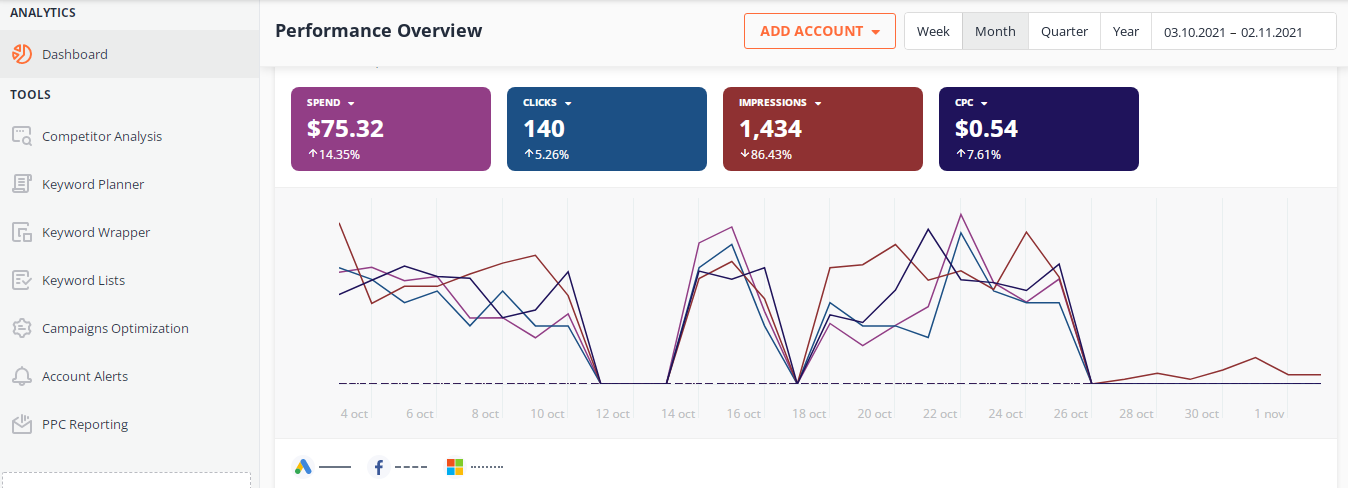
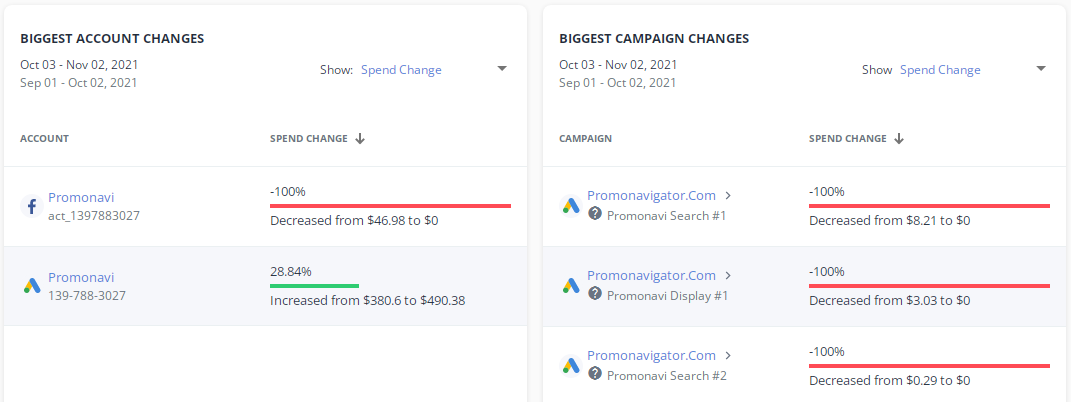

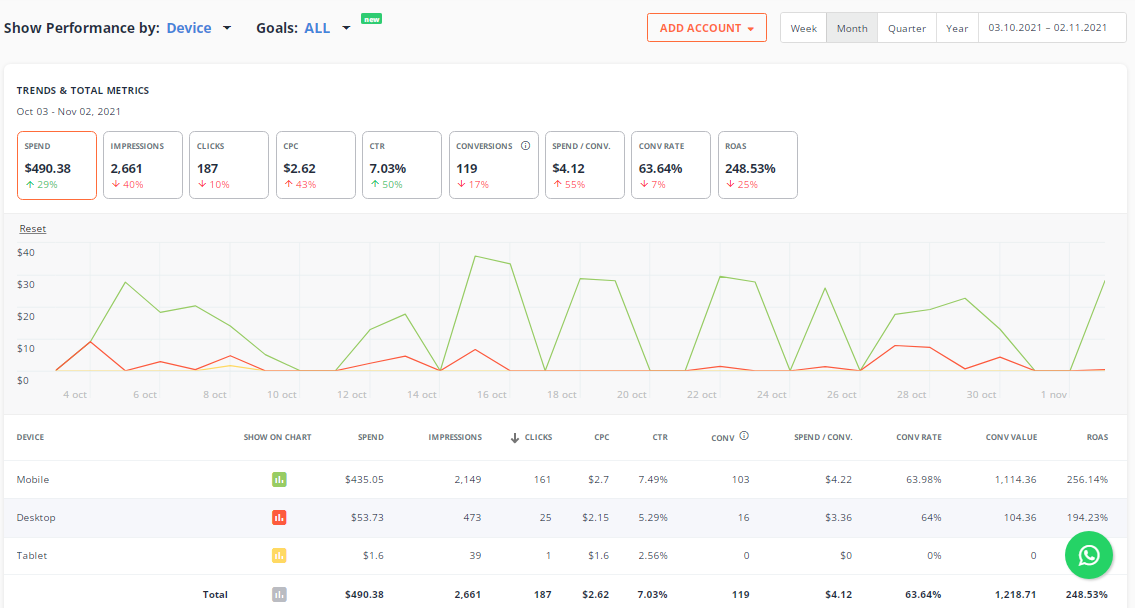
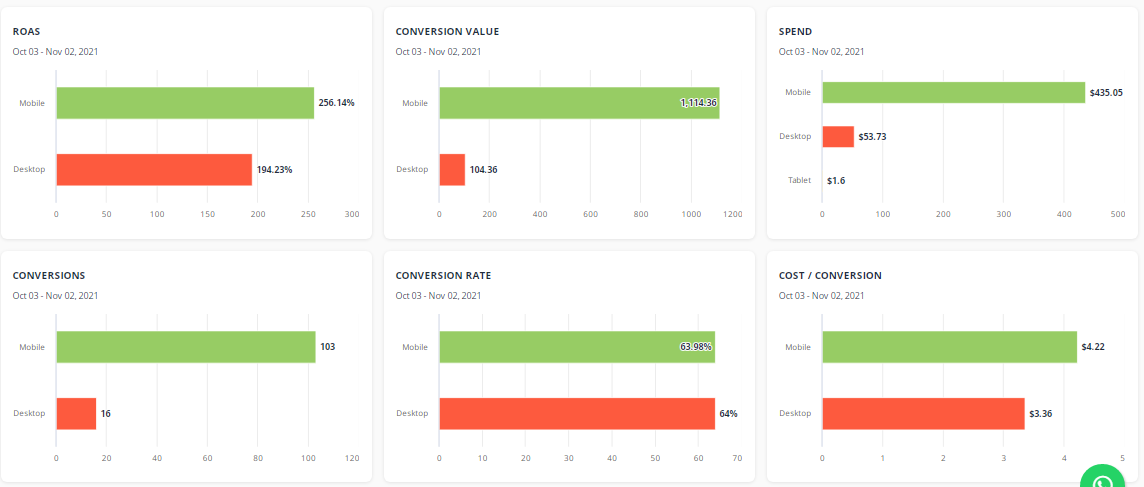


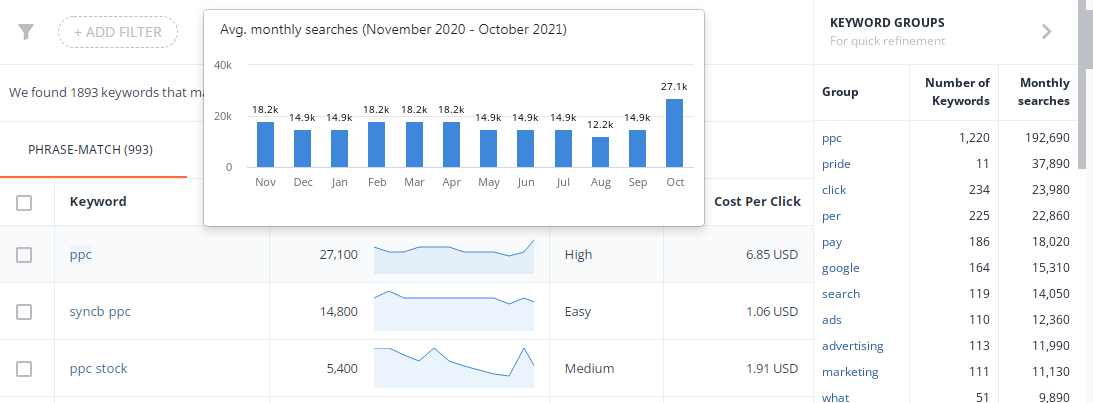
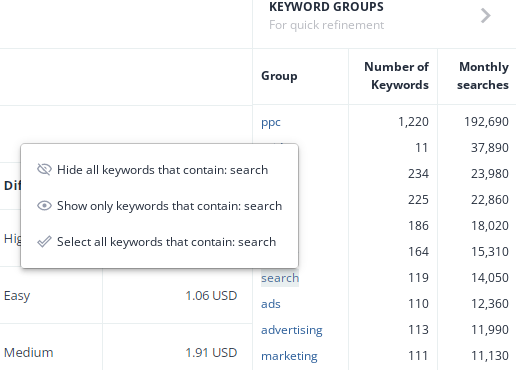

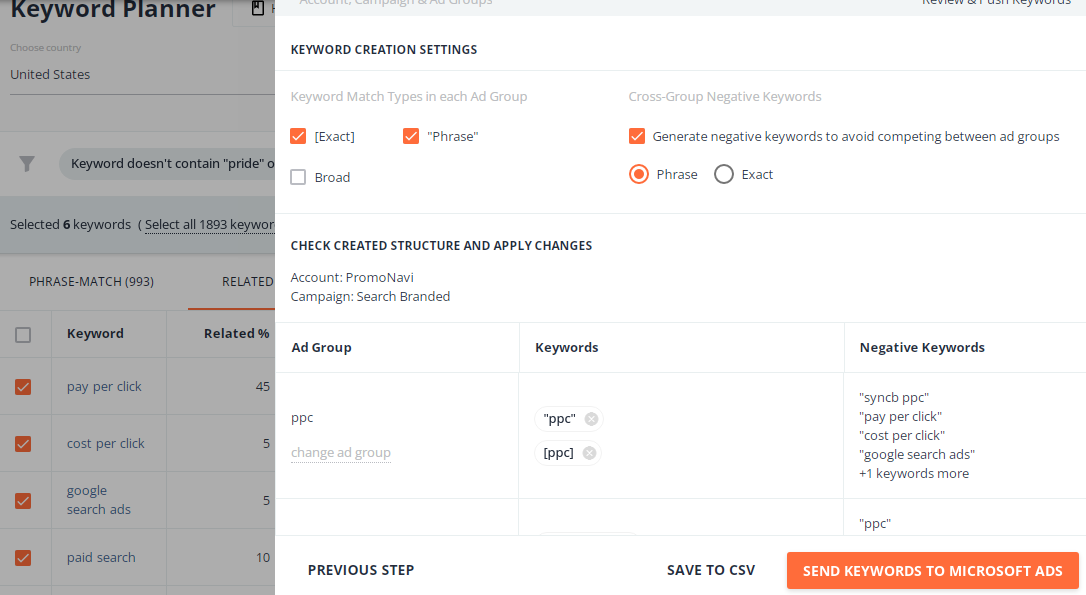
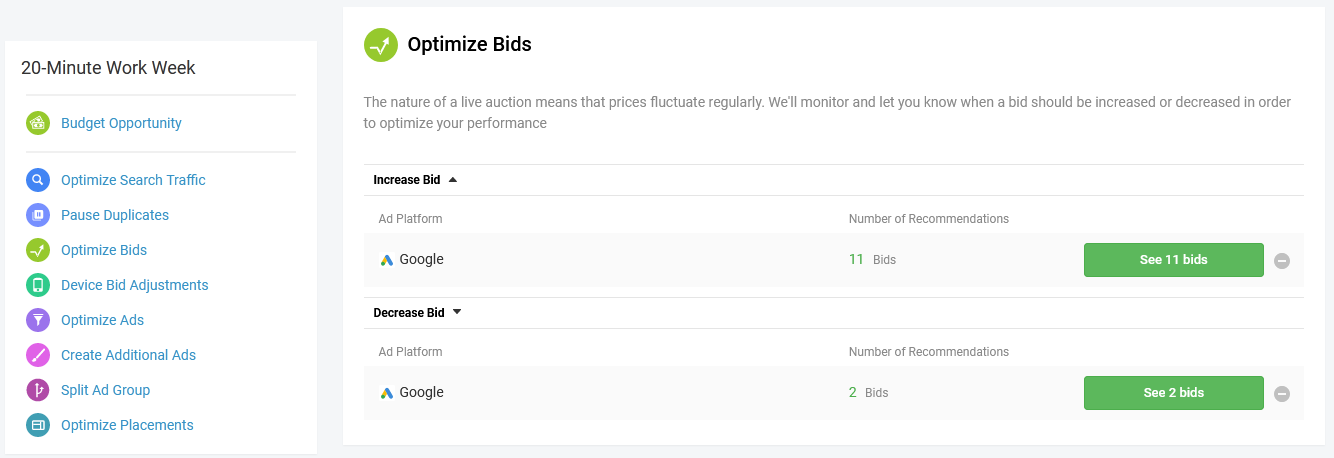
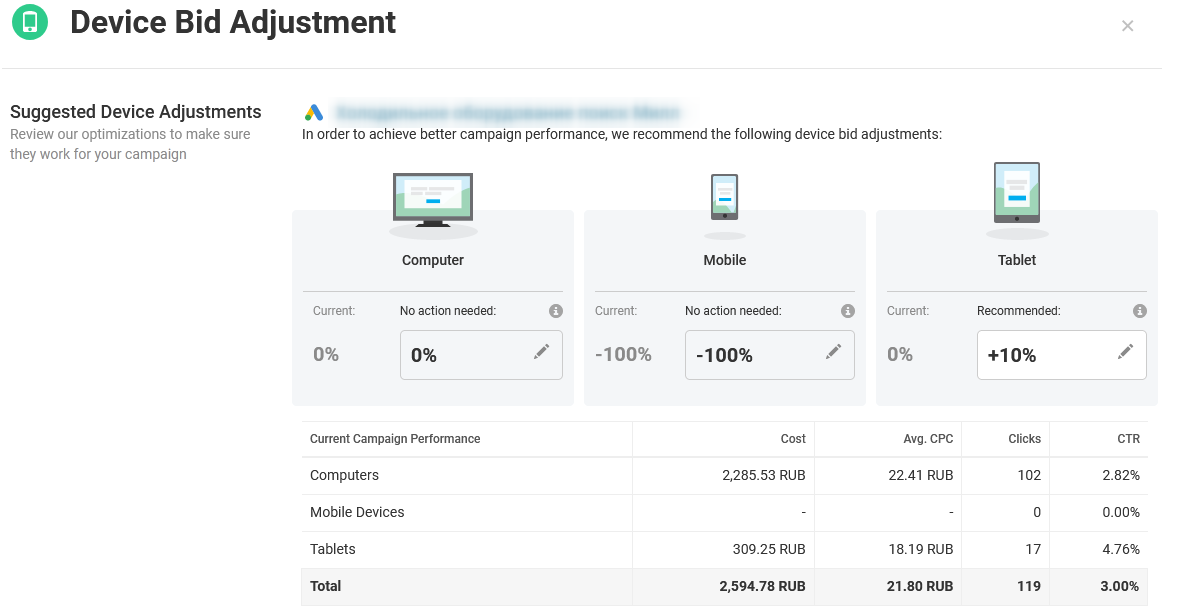
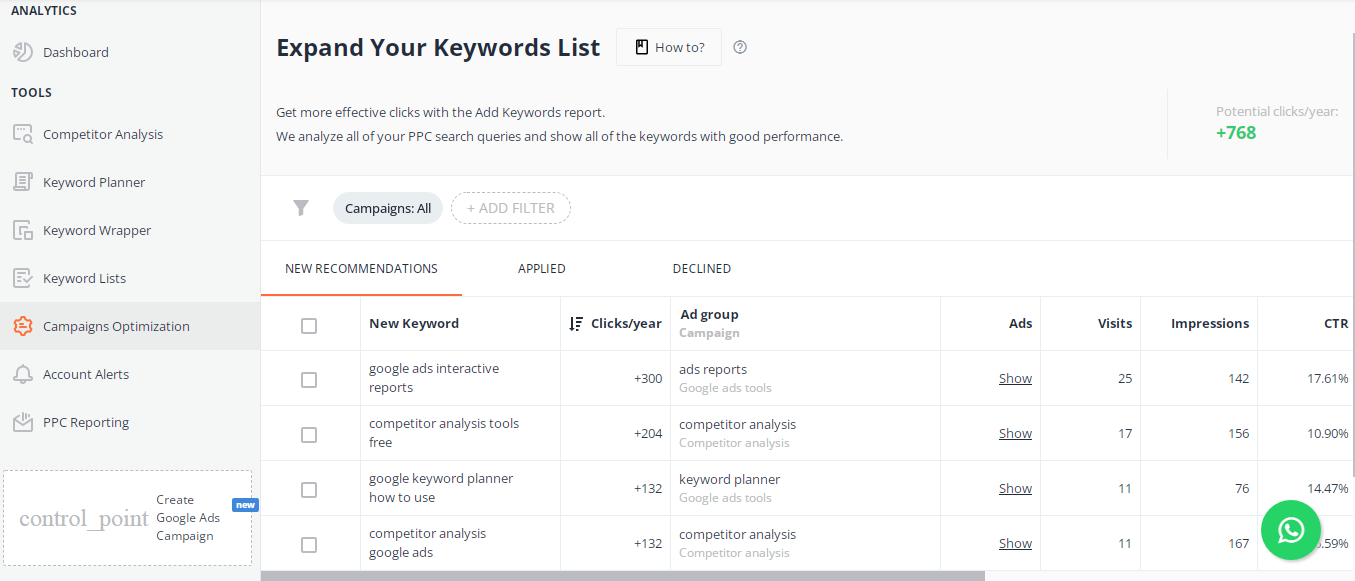
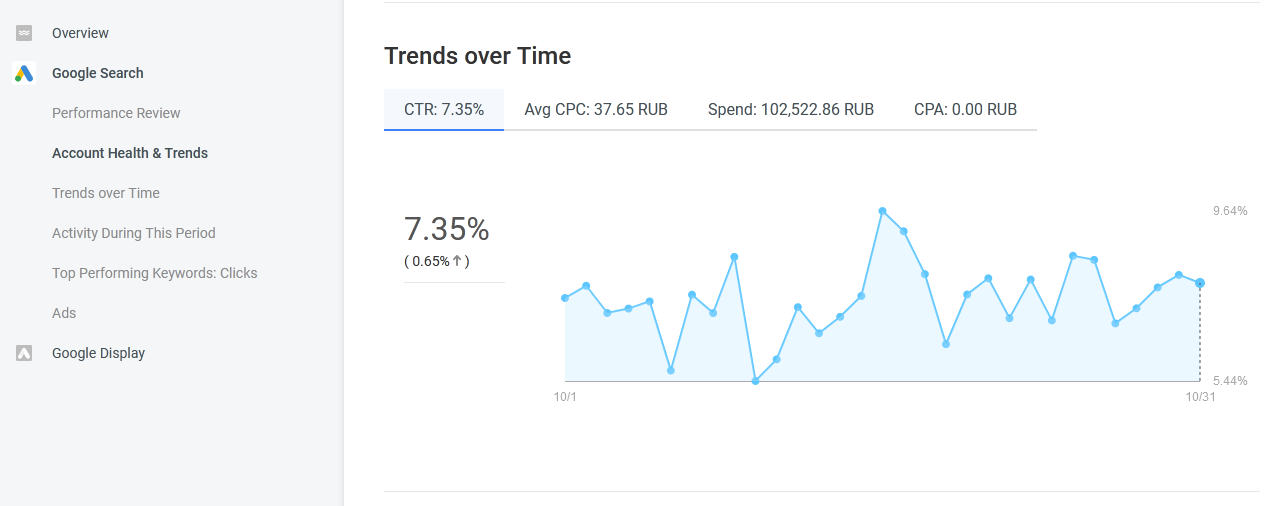


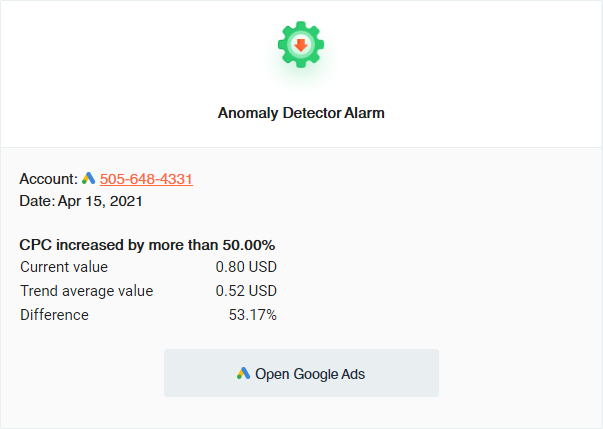
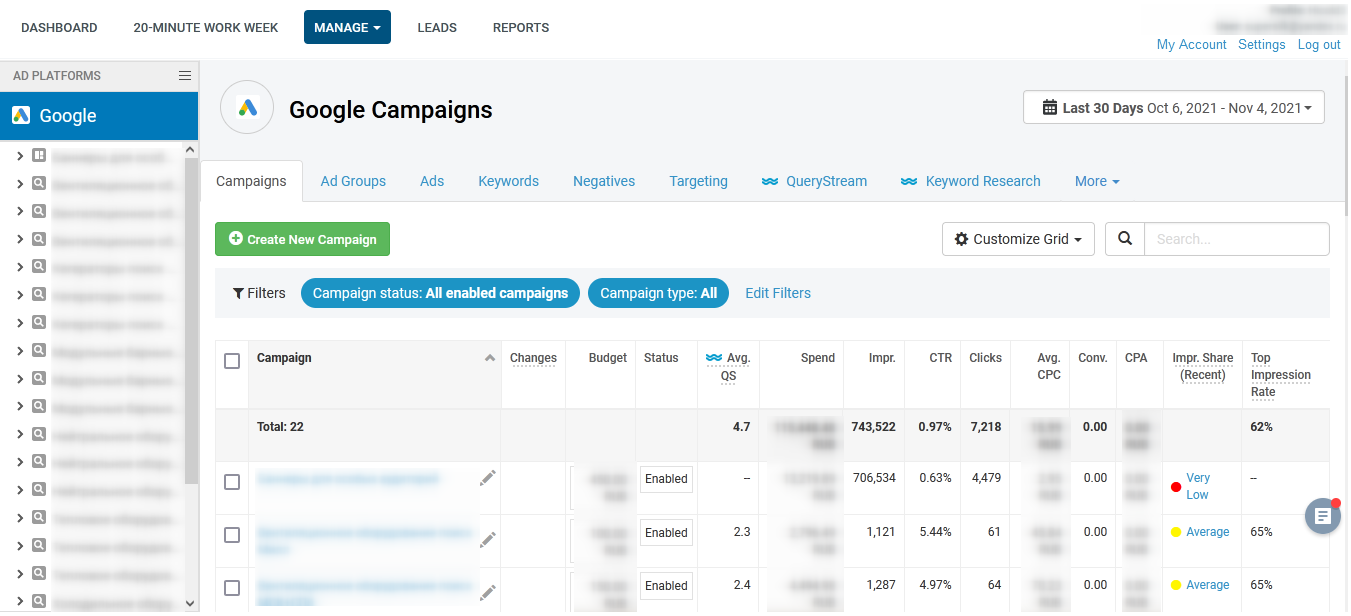
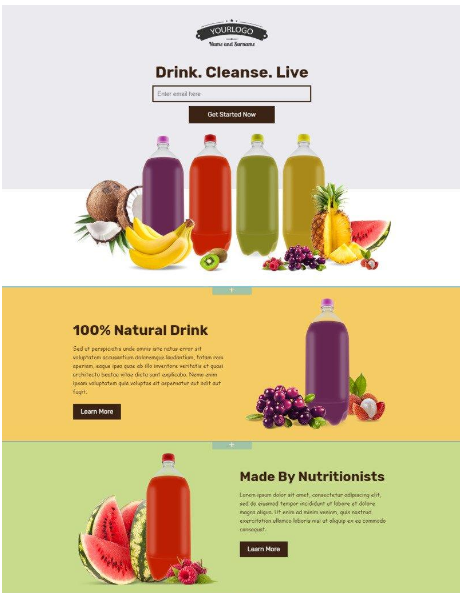
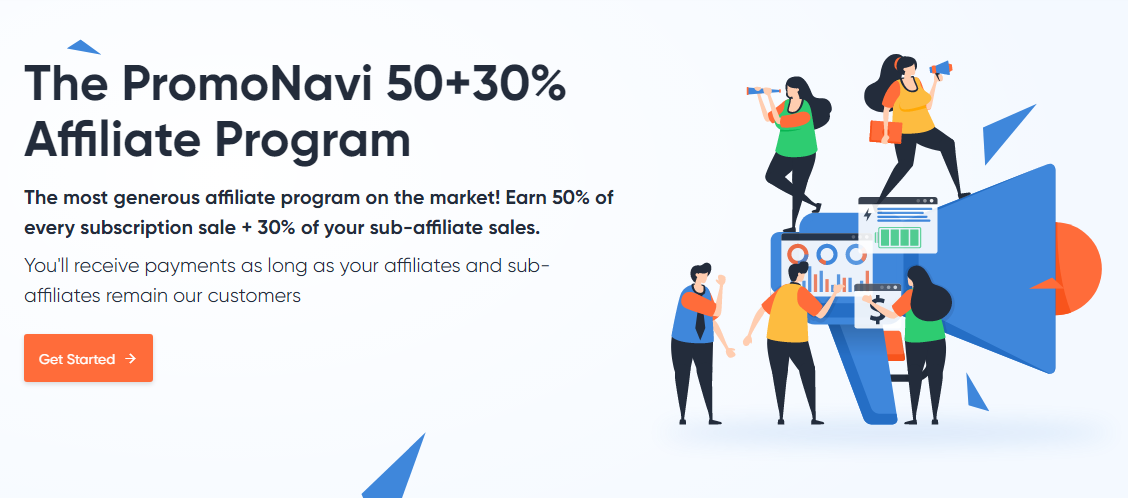

![How to Set Up Automated Rules in Google Ads [10 Real-Life Examples]](https://blog.promonavigator.com/wp-content/uploads/2021/01/automated-rules-600-360-1.jpg)

